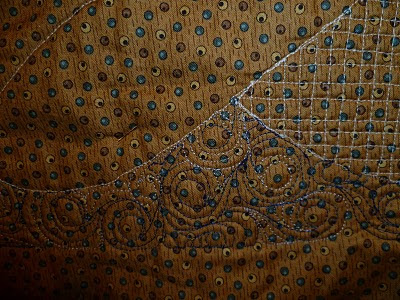Becky picked out some blue fabrics from my stash and asked me to make her a blue dragonfly. I had just made the Highland Dancing Fairy with see-through wings so I wanted to use the same technique for the dragonfly wings.
The first step was to draw some dragonflies or parts of dragonflies. I think one of these is actually a grasshopper!

The bit of green fabric was a trial of a foil. More on that later.

I couldn't use all the lovely blue fabrics that Becky had chosen as a background. A blue dragonfly on a blue background wouldn't have worked. So I decided to use them in the border. The dragonfly image that I liked the best was actually not a real one but a painting by
Katsushika Hokusai, a Japanese painter from the Edo period. I love the look of this period, which is probably why I love my vases. One of things that characterised the art of the Edo period is that objects were not necessarily grounded in the background. Things are not realistic but the beauty of each object was shown at its best. I decided to use this idea in my design. I had bought a lovely pink floral fabric in three designs, each one in the same colourways but different sizes of flowers. I wanted to use the three sizes as foreground, background and distance but this is not a realistic landscape quilt so more flowers and less leaves!
This is my sketch.

To get the proportions right, I scanned in the flowers and my sketch and messed about in Paint to put the two together. I can't wait to get a proper programme but Paint works for what I do. Then I projected that image using a data projector at school and blew it up until the image of the flowers was the size of the actual flowers on the fabric. Then I traced the dragonfly and the position of the flowers and border on to stabiliser and used that for the positioning and dimensions.
I made the wings using two layers of a fine net, one layer of soluble stabiliser and a tear-away stabiliser. The tear-away was removed from the middle after stitching the outside of the shape. I also added a little Angelina fibre to the wing tip and more where the wing joins the body. The bottom wing has been washed to remove the stabiliser.

At this stage I had put all the blue border together by randomly cutting strips and sewing them together. Then I cut some blocks at an angle and fitted them together to make strips. I left the outside edge all random lengths and cut the inside edge straight and added to the green background. I had also added the foil at this stage. The idea is that this is a shady pond with oily slicks or ripples. Here I have pinned all the elements I have so far to the design board to see if I need more foil. My big patch didn't come off the acetate as well as the other two patches but I figure I can cover most of the blotches.

I made up a mitred border and then used spray adhesive to temporarily attach the middle plus blue border to the orange border. The blue border was then satin stitched to the orange border. I liked the way that the orange border looked like a wood frame.
I added more flowers using raw edge applique and invisible thread and I used a fabric pen on the distance bush (top left corner) just to give it a bit more definition.
The branch in the foreground was applied using a whole cloth applique method. I'm moving away fusing applique. I don't like the way it makes the fabric hard. Whole cloth applique is just that, the whole piece of fabric applied to the front of the work. Then I work from the back using the stabiliser on to which I traced the design. After sewing around the leaves and stem, I removed the stabiliser and trimmed the fabric back to my sewing line. Then I used free-motion embroidery on the stem and satin stitch around the leaves. I added another leaf to the design since Becky wanted the dragonfly sitting on a leaf - and what the client wants, the client gets! By using fabric pen and a different colour of thread for the stain stitch on the curled part of the leaf, I managed to give the impression of the underside of the leaf without looking for another fabric and fiddling with small pieces.

This was a sample for the dragonfly body. I like to do that not only to try out a technique or, in this case, the holographic thread, but also so that I have something to put in my scrapbook.

And the finished quilt.





















































